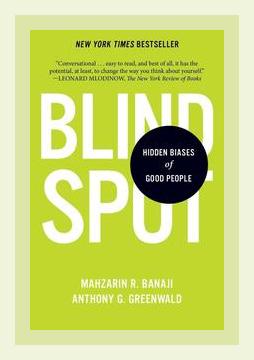Human Resources and Talent ManagementDiversity and Inclusion
Summary: Blindspot: Hidden Biases of Good People
Authors: Mahzarin R. Banaji and Anthony G. Greenwald
Publication Year: 2013
Categories: Diversity and Inclusion
“Blindspot: Hidden Biases of Good People” authored by Mahzarin R. Banaji and Anthony G. Greenwald addresses the implicit biases that reside within even well-intentioned individuals. This book unpacks complex psychological research in an accessible format to help readers recognize and mitigate unconscious biases. Below, I provide a structured summary of the key points and actionable steps from the book.
1. Introduction to Implicit Bias
Key Point:
Banaji and Greenwald introduce the notion of “blindspots,” or implicit biases, which are subconscious attitudes or stereotypes that affect our understanding, actions, and decisions. These biases are often contrary to our declared beliefs.
Concrete Examples:
– The Implicit Association Test (IAT): This tool was developed to measure unconscious biases and reveal discrepancies between our conscious attitudes and hidden preferences. For instance, an individual might declare neutrality towards races but show a hidden preference for one race over another in the IAT.
Actionable Step:
Self-Assessment: Take the IAT available online to identify your own implicit biases. Understanding your starting point is crucial to developing strategies to counteract these biases.
2. Origins of Implicit Bias
Key Point:
Implicit biases originate from cultural messages, societal norms, and personal experiences. These biases operate below conscious awareness, influencing our judgments and behaviors subtly and pervasively.
Concrete Examples:
– Cultural Stereotypes: Media portrayal of gender roles can embed specific associations, such as associating men with leadership and women with caregiving.
– Personal Experiences: Early interactions might shape an individual’s unconscious preferences, such as a child favoring faces similar to their caregivers.
Actionable Step:
Reflective Journaling: Regularly reflect on your experiences and media consumption. Question the messages and stereotypes that you encounter, and consider how they might influence your internal biases.
3. Real-Life Impacts of Implicit Bias
Key Point:
Implicit biases have tangible consequences in various spheres like hiring practices, medical treatment, and law enforcement, contributing to persistent inequality.
Concrete Examples:
– Hiring Practices: Résumé studies show that identical applications are judged differently based on implied race or gender, with “white-sounding” names receiving more callbacks than “Black-sounding” names.
– Medical Treatment: Studies highlight disparities in pain management, where minority patients are less likely to receive adequate pain relief compared to white patients.
Actionable Step:
Structured Decision-Making: Implement standardized procedures and criteria in decision-making processes to ensure fairness. For example, anonymize applications in hiring to mitigate name-based biases.
4. Recognizing and Acknowledging Bias
Key Point:
Acknowledgement of implicit biases is the first step towards mitigating their effects. Denial or ignorance of these biases perpetuates systemic inequities.
Concrete Examples:
– Accountability: Leaders in organizations who acknowledge their biases can create opportunities for training and systemic change.
Actionable Step:
Awareness Training: Participate in or organize bias training workshops. These sessions can help individuals recognize their biases and understand their impacts on others.
5. Strategies for Counteracting Implicit Bias
Key Point:
There are effective strategies for reducing the influence of implicit biases, including mindfulness, exposure to counter-stereotypical examples, and diversifying experiences.
Concrete Examples:
– Exposure to Counter-Stereotypic Imagery: Viewing images of successful individuals from stereotyped groups can reduce implicit biases.
– Perspective-Taking: Imagining oneself in another person’s situation can increase empathy and reduce bias.
Actionable Step:
Diversification Exercises: Regularly engage with materials, activities, and people that challenge your stereotypes. This could include reading books by authors from diverse backgrounds or participating in community events.
6. The Role of Institutions
Key Point:
Institutional policies and practices play a crucial role in perpetuating or mitigating biases. Organizations must take proactive measures to create inclusive environments.
Concrete Examples:
– Equal Opportunity Policies: Organizations with stringent anti-discrimination policies foster a culture of inclusion.
– Representation: Schools and workplaces with diverse representation in leadership positions showcase commitment to diversity.
Actionable Step:
Inclusive Policy-Making: Advocate for and help develop policies that promote diversity, equity, and inclusion within your organization. Ensure that these policies are regularly reviewed and updated as necessary.
7. Social Implications
Key Point:
Implicit biases shape societal structures and relationships, contributing to systemic discrimination and social stratification.
Concrete Examples:
– Segregated Housing: Historical and ongoing biases contribute to racially segregated neighborhoods, which in turn affect educational and economic opportunities.
Actionable Step:
Community Engagement: Join local advocacy groups that work to combat segregation and promote equity in housing, education, and economic opportunities. Participate in forums and discussions to stay informed and proactive.
8. Moving Towards Collective Change
Key Point:
Collective awareness and action are essential for substantial change. Advocacy, education, and continuous learning can help in creating a society free from the shackles of implicit bias.
Concrete Examples:
– Educational Programs: Universities and community organizations that offer courses on implicit bias and intercultural competence significantly contribute to public awareness.
Actionable Step:
Public Advocacy: Use your voice and platform to raise awareness about implicit biases. Support and collaborate with educational institutions and advocacy organizations to promote widespread understanding and change.
Conclusion
“Blindspot: Hidden Biases of Good People” offers valuable insights into the unseen biases affecting our judgments and actions. By recognizing and addressing these biases, individuals and institutions can work towards creating a more equitable and inclusive society. Implementing the actionable steps suggested in this summary can help mitigate the influence of implicit biases and foster positive social change.
Human Resources and Talent ManagementDiversity and Inclusion
